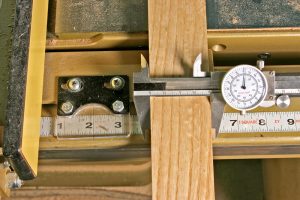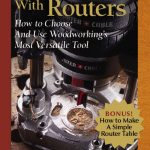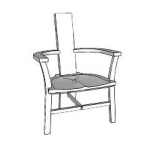We may receive a commission when you use our affiliate links. However, this does not impact our recommendations.
 One of the sure signs of getting old is finding out that the kid who works in the next cubicle never heard of the TV show “WKRP in Cincinnati.” Another sign is remembering something that is taken for granted today was at one time brand spanking new. Our web guy wasn’t even born in 1982 when “WKRP” was canceled, but it was about that time that I ponied up $300 to put a Biesemeyer fence on a hand-me-down Delta contractor’s saw. Until then, setting the fence on a table saw was one of the things that gave cabinetmakers the reputation for being fussy and fiddly. My new fence improved my productivity and my accuracy in ways I couldn’t imagine. But part of installing the fence also changed the way I looked at accuracy – the section of the manual that recommended calibrating the fence by using a pair of calipers to measure the results of the cut.
One of the sure signs of getting old is finding out that the kid who works in the next cubicle never heard of the TV show “WKRP in Cincinnati.” Another sign is remembering something that is taken for granted today was at one time brand spanking new. Our web guy wasn’t even born in 1982 when “WKRP” was canceled, but it was about that time that I ponied up $300 to put a Biesemeyer fence on a hand-me-down Delta contractor’s saw. Until then, setting the fence on a table saw was one of the things that gave cabinetmakers the reputation for being fussy and fiddly. My new fence improved my productivity and my accuracy in ways I couldn’t imagine. But part of installing the fence also changed the way I looked at accuracy – the section of the manual that recommended calibrating the fence by using a pair of calipers to measure the results of the cut.
I didn’t own any calipers at the time, so I tried to use every other measuring device I own. After a wasted afternoon producing a bunch of sticks that were almost 2″ wide, I went and bought a pair of fractional dial calipers. That decision was as big a boost to my skill set as buying the fence.
Calibrating the fence is a simple process. Set the indicator to 2″ and cut a piece of wood. Measure that piece of wood with the calipers, then readjust the scale to the dimension on the caliper. Reset the fence to 2″ and try again. When the numbers agree, you have an accurate and reliable scale on your saw. In the photo (you can click on it to make it larger), the fence setting is 1/64″ over.
 I know that several readers at this point are saying, “wait a minute that’s pretty close, certainly close enough for woodworking.” I’m a complete slob in the shop in many ways, but I am convinced that the tolerances for good work are much closer than 1/64″. Try fitting a tenon that is 1/64″ too big into a mortise. You don’t have a hammer big enough. Put a tenon that’s 1/64″ under-size in that mortise and it falls right out. If you make the choice to work to close tolerances, you need to think about the tools and methods you use and the thinking that goes along with your choice. The benefit is you no longer have to work by guessing.
I know that several readers at this point are saying, “wait a minute that’s pretty close, certainly close enough for woodworking.” I’m a complete slob in the shop in many ways, but I am convinced that the tolerances for good work are much closer than 1/64″. Try fitting a tenon that is 1/64″ too big into a mortise. You don’t have a hammer big enough. Put a tenon that’s 1/64″ under-size in that mortise and it falls right out. If you make the choice to work to close tolerances, you need to think about the tools and methods you use and the thinking that goes along with your choice. The benefit is you no longer have to work by guessing.
Here’s what the scale looks like after adjusting. Again, you might want to click on the image to make it larger. The scale only reads to 1/32″, but if you look carefully you can work to twice that resolution by placing the cross hair in between the lines. You may have to turn on some extra lights, get your reading glasses, close one eye and position your eye directly over the scale. That sounds like a hassle, but it’s worth it.
Having an accurate saw (and a way to measure) led to several things for me. I went through my tool inventory and got rid of or fixed all the squares, tapes and rules that weren’t right on the money. When the tools were set, I had to adopt some standards for how I measured. For the most part, that involved using the right tool for the task, and using it the right way.
 In this photo, I’m using an extremely nice 6″ rule to measure the thickness of this board, but I’m making some fundamental mistakes. If my tool-and-die maker grandfather were still around he would chew on me for about half an hour regarding my technique. What’s wrong with this picture? I don’t have a good point to measure from. I lined up the end of the ruler with one edge of the board with my thumb, and I shifted my hand a little bit right after that. Is this hunk of wood 7/8″ as the number at the top suggests, or is it 1/32″ smaller as the number at the bottom is telling me? My reading would be far more precise if I took another piece of scrap, held it to the edge of the board and placed the end of the rule against that.
In this photo, I’m using an extremely nice 6″ rule to measure the thickness of this board, but I’m making some fundamental mistakes. If my tool-and-die maker grandfather were still around he would chew on me for about half an hour regarding my technique. What’s wrong with this picture? I don’t have a good point to measure from. I lined up the end of the ruler with one edge of the board with my thumb, and I shifted my hand a little bit right after that. Is this hunk of wood 7/8″ as the number at the top suggests, or is it 1/32″ smaller as the number at the bottom is telling me? My reading would be far more precise if I took another piece of scrap, held it to the edge of the board and placed the end of the rule against that.
 Better yet is to pick up the calipers. With a jaw on each side there isn’t any guesswork about where I’m measuring from or where I’m measuring to. With the rule I wasn’t quite sure what I had, and it turns out that both of my guesses were wrong – one too high and one too low.
Better yet is to pick up the calipers. With a jaw on each side there isn’t any guesswork about where I’m measuring from or where I’m measuring to. With the rule I wasn’t quite sure what I had, and it turns out that both of my guesses were wrong – one too high and one too low.
It doesn’t always matter if you hit the number you were aiming for. If this piece didn’t need to fit into something, or match something, it’s every bit as good as a piece that’s really 7/8″ thick. But there are plenty of times that it matters a lot. And if you don’t know exactly what you have, you’ll end up guessing about what’s important and what isn’t too.
Here are some supplies and tools we find essential in our everyday work around the shop. We may receive a commission from sales referred by our links; however, we have carefully selected these products for their usefulness and quality.










As a past aerospace machinist I concur with most of the posts here. I have used all kinds of measuring instruments from 6″ rules to light waves and am comfortable with with my quality German made Craftsman dial calipers. The only suggestion I would make is to use a steel block of known exactness to compare the zero setting to 1″ and 2″ and so on. The dial may not read exactly what you open it to even if it is at zero when beginning. Most important to me is that the tool repeat every time you measure something other than zero. Your caliper may read “0” at zero but may read “1.0030” when opened. If it repeats this every time then you just remember deviation.
Remember, measure twice and cut once!
I must agree with you completely. Being a toolmaker/machinist my dial calipers are always on my bench. A while back I even wrote a blog article on this subject. http://newbritainboy.wordpress.com/2011/02/24/31/ However, you put it much more leoquently than I did.
I’ve used one of these calipers(the plastic one made by General) in my woodworking almost from the start, 25 years ago and I use it nearly every time I’m in the shop which is almost everyday. Over the years I’ve acquired quite a collection of them. I think I have at least six of seven different brands of them to date. and I’m with what repeter said on using a non digital one. The digital ones in my experience don’t seem to be as accurate and it seems I’m always replacing the batteries in them. The one I like to use most is the one with measurements in 64ths and hundredths of an inch. Because of my experience with these digital calipers I’m not a fan of any digital tools, except for one. That being my digital fence set up from Accurate Technologies. In combination with my Beismeyer fence I can get consistent accurate repeatable measurements within several thousands of an inch. Probably the best upgrade I’ve ever made to my table saw. Extremely helpful when cutting multiple matching dadoes.
Have a Ridgid saw with supplied fence which is reasonable.
Other fences may be more accurate, but my concern is repeatability. I use a piece of wood of the desired width
between the blade and fence to adjust and make all similar
cuts at the same time when possible.
Have a mortise and tenon jig, but don’t use it anymore,
as I only use the Leigh FMT with router for that purpose.
I have an adjustable router jig to do dados, so my table
saw is only used for crosscutting and ripping.
I work almost exclusively with pine which is not 100%
stable, so extreme accuracy a bit elusive.
I would never measure to the end of a rule, if the only
device at hand, start at 1 inch mark. Of the many calipers
I have, one measures to 4 decimals, but pine is soft, and
depending on how tight I squeeze the material, I can get
quite a variation in readings.
The proof is in the fit in the end.
Great article! Accuracy when done during the cut is a whole new world.
It is amazing what accuracy one can get from a good fence calibrated with a dial caliper on a table saw. I have a similar fence that came with my Jet cabinet saw and has the benefit of having two lines on the sight glass that are about 1/8 apart to eliminate parallax. What a boon to my productivity. A 1″ rip is good to plus or minus 9 thousands, something that I could not have imagined in my younger days.
Another side benefit in having a really great fence is that when I want to make a 14″ crosscut I can use the fence to measure the cut and easily swing the fence aside during the cut. I only have to measure once and it comes out perfect every time.
Long before I was a woodworker I was a machinist. The term “dial it in” was the opposite of “calling it in” and I came to appreciate not only the precision, but the repeatability of “dialing it in.” Resetting the fence on my Jet cabinet saw to the exact place it was before was impossibility. I could get close–acceptably close given wood movement–but it was always an pain and cause for anxiety.
When I upgraded to a SawStop (yes, I can be careless and I know it!), I added a Incra fence. It is awesome! Combine that with a digital depth gauge and I can repeat a setup quickly, accurately and without the anxiety. Now I can do things in the order that makes sense to me, not that requires all the same operations to be done at once.
… and then we have http://www.popularwoodworking.com/woodworking-blogs/chris-schwarz-blog/%E2%80%98i-want-my-micrometer-%E2%80%99
The first “unapproved” song (my teacher believed music died around 1870) was the theme song to WKRP. Yes lock your doors mothers, I was a real hell raiser.
“Baby, did you ever wonder? Wonder whatever became of me. I’m livin’ on the air in Cincinnati. Cincinnati, WKRP”
“I have recently lost sight in my left eye, and find that my woodworking results have improved immensely”
It is possible you are looking closer, but it is more likely you are right handed, and had left eye dominance, a pretty frequent occurrence(ask some skeet/trap shooters about this, hardly ever discussed amongst woodworkers, though it should be) By losing your dominant eye you are now forced to do what shooters have to do with this situation to maintain the line between their eye, and any other point of reference, which is to shut the dominant eye. Typically shotgunners are told to shoot with both eyes open, in reality it only works out around 60% of the time. Woodworkers will share this problem as they try to look at a fixed point. I would add to our fully sighted friends that they play around with measurements by using a ruler, and then check their work with a caliper. Won`t take many tries to see if you eye dominance and hand dominance are the same. To switch eyes, just close one or the other, your brain is pretty smart, and instantly makes the adjustment for you. It`s why some people squint to “look” at things.
Bob, great post. Many of the blog posts are fluff, puff and not so relevant stuff. This is Meat and Taters. Thanks
I really have not measured the last few projects I’ve made. I’m going to pretend my parts were accurate. Or at least precise.
I like the fractional ones I use because I think in fractions, not decimals. I know the decimal equivalents up to 1/8″s, but beyond that I can’t remember them. You can lock the jaws to a distance by tightening the teeny knob on the slide. This is a real value that I should have mentioned in the post-lock in a distance and use the calipers for comparison. You can also see if you’re a “hair” over or under.
I’ve been underwhelmed with the digital calipers I’ve used, especially the ones that read in fractions. 1/64″ is .0156″, and the digital fractional calipers are rounding off by half that much with every measurement. In other words, what the tool says could be up to .008″ high or 008″ low for any given reading, and there isn’t any way to tell without switching to decimals. The trouble with digital devices that read in thousandths is the hypnotic effect of watching the display bounce back and forth between .023″ and .024″ depending on your pulse rate or blood pressure.
I actually haven’t used my nice set of calipers as much as I have recently, and I’m finding that my work is improving a lot.
(Something to do with the old eyes going…lol)
Thanks Bob, you are right on the money as usual.
Thanks Robert,! I needed that. I have recently lost sight in my left eye, and find that my woodworking results have improved immensely, in that I am being much more cautious in my measurements. Paralax is no longer a problem in setting fences and planner thickness gauges. And, yes I am now also using a 6″ engineering rule to take some measurements.
Here is a question I have thought about for some time now. I see you are using an analog caliper. Is an analog caliper better than a digital one? I have both and I find that some times when I go back with the digital, I get a different reading and have to zero it out and start alll over again. The analog seems to hold truer but with my 67 year old eyes, it’s harder to get the finer measurement.
pfff, why being so miserable, what is your point?